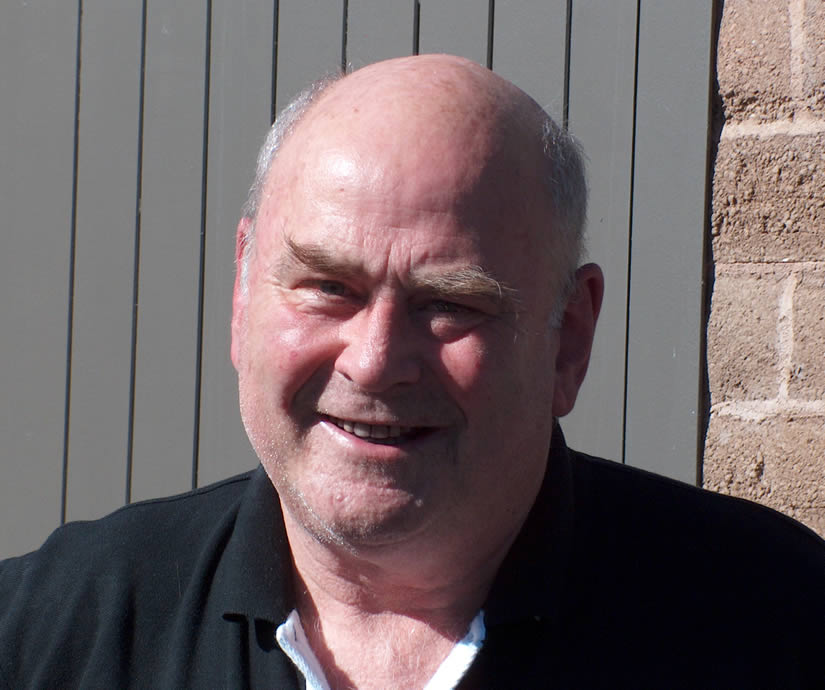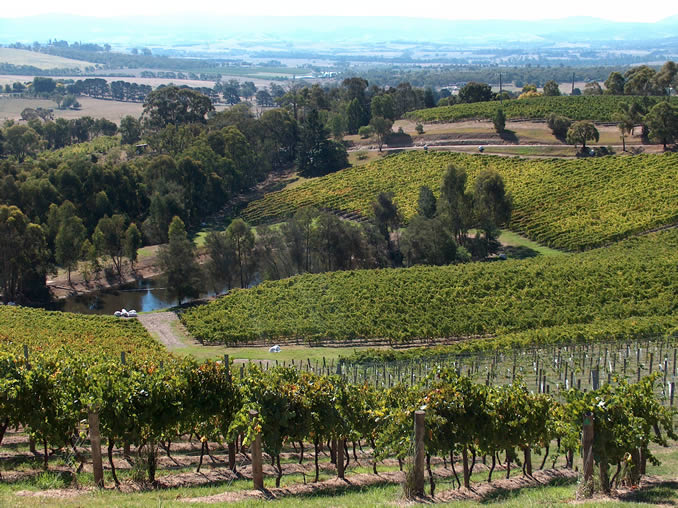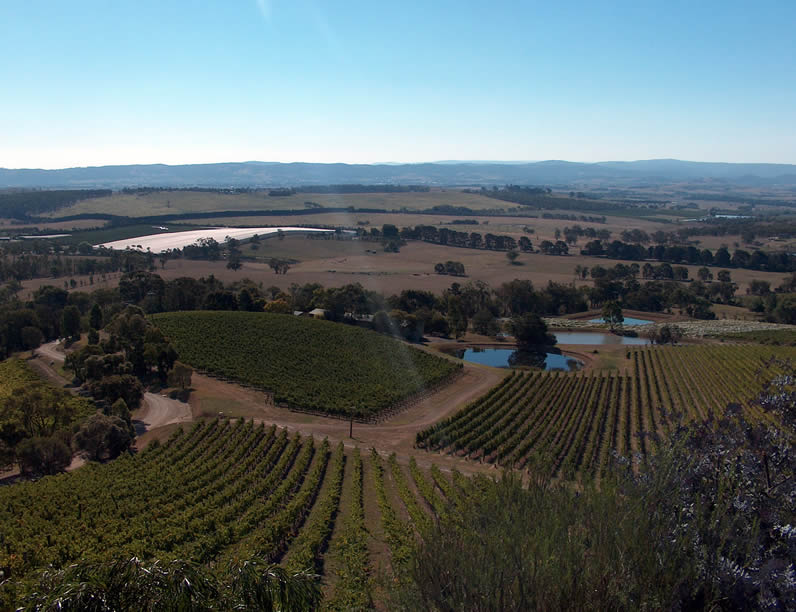|
The
James Halliday
interview
Jamie
Goode
meets Australia's leading wine journalist, who's also a celebrated
winemaker. [Click here for a printable
version of this article in pdf format.]

Over
the last few years, I’ve been fortunate enough to have had the
opportunity to meet some of my wine heroes. On this occasion, though,
I was especially pleased to be meeting James Halliday, simply because
he was the writer whose words introduced me to wine back in the early
1990s. You see, I learned wine the wrong way: rather than start with
the Old World classics in time-honoured fashion, I began with
Australian wine, and Halliday was my guide (with a bit of Oz Clarke on
the side): I still have the well thumbed copy of Sainsbury’s
Guide to Australian Wine which was my first wine book. Halliday is
one of the easiest of all wine writers to read: he has an infectious
style—friendly, flowing and authoritative.
When
I met him at the Coldstream Hills winery in Australia's Yarra Valley,
it was late afternoon on a hot early Autumn day. His teeth were
stained from tasting another 150 wines for his annual wine guide: the
deadline was close, altogether some 5000 wines need sampling each
year—a task that’s more arduous than it sounds. James went off to
fetch a couple of ice-cold Coopers, and we sat and chatted about his
career in wine.
James
was introduced to wine through his father, a doctor, who created a
small cellar in the Halliday family home in Bellevue Hill, Sydney. In
these postwar years, drinking table wine wasn’t a common practice in
Australia: fortified wine was dominant, and as late as 1960 this
accounted for some 90% of all vineyard production. Wine writing
didn’t exist outside trade publications, and the table wines that
existed went under pilfered generic names such as Claret, Burgundy,
Hock, Riesling and Chablis.
In
1956 James began studying law at the University of Sydney, beginning
his career as a lawyer in 1962, becoming a partner at Clayton-Utz in
1966. It was in the mid-1960s that he met his mentor, the legendary
Len Evans. Evans was Australia’s first great wine communicator, and
is credited by many as having a pivotal role in the amazing success of
the Australian wine industry through the 1970s and 1980s. ‘He
succeeded because he had a natural palate, and an ability to draw
people towards him’, recalls Halliday. Around this time Evans opened
Bulletin Place, a fine wine shop and restaurant housed in a historic
1816 warehouse. Every Monday, Evans would host a small group of three
lawyers—James, Tony Albert and John Beeston—and restaurateur
Neville Baker, for lunch, in what became known as Bulletin Place Front
Row.
Through
this, Len introduced James to French wine. In 1967 Len served James a
1962 La Tache, an experience James describes as ‘the beginning of
the end’. Significantly, Bulletin Place introduced this group to the
great wines of Europe. It also led to James’ first writing
commission, and eventually spurred James, John Beeston and Tony Albert
to establish their own winery in the Hunter Valley.
They
spent a couple of years searching, but in 1970 succeeded in buying a
10 acre block near the intersection of the McDonalds and Broke Roads
in Pokolbin. This was to become Brokenwood. The first acre and a half
was planted in 1971, and the three lawyers got their hands dirty doing
a lot of the tractor work and planting themselves (‘it was
agonizing’, James recalls), as well as the pruning and picking. The
first wine was made in 1973, from a ton of Shiraz and half a ton of
Cabernet, at Rothbury. ‘We did the Shiraz in an open-top fermenter,
and when the three of us were due back in Sydney we had to press it
and put it in barrel at 2 Baume’, [before fermentation had
completed] says James. ‘At that stage barrel fermenting of reads was
already done with Grange and at Wolf Blass, but people didn’t talk
about it.’ Halliday stumbled on it and it has been part of his
winemaking toolkit ever since. He was involved with Brokenwood for
just over a decade, but had to leave when he moved to Melbourne in
1983.
Despite the excellence of the Brokenwood wines, it is as a wine writer
that Halliday made his greatest contribution to the Australian wine
scene. Most of this work was done while he was still a Partner at
Clayton Utz. ‘I was doing a lot of corporate work involving heavy
duty finance’, he recalls. ‘I caught a lot of planes, so it was an
ideal environment for writing. ‘I read voraciously as a child and
trained as a lawyer, and I had the lucky ability to write things well
the first time.’ His first book was The
Wines and History of the Hunter Valley, written in the late 1970s,
and he began to gather an impressive array of newspaper and magazine
columns. Further books followed, concentrating on the wines from each
of the major wine-producing states. It was while James was researching
the Victorian book that the seed for the next episode in his life
began to form. From his Bulletin Place days he’d nurtured a love of
Pinot Noir, and the Pinots he tried from Seville Estate and Mount Mary
in the Yarra Valley in 1978 impressed him greatly. ‘They were so far
away from anything else being made at the time in Australia’, he
remarks. ‘It was love at first sight, and I knew that some day,
somehow, I would end up in the Yarra Valley.’

The vineyards at Coldstream Hills in
the Yarra
In
1983 James and his wife finally got to move to the Yarra, as he moved
to Clayton Utz’ Melbourne office, on the understanding that if he
wanted to retire in five years time to concentrate solely on wine,
that would be fine. His initial plan was to make wine from bought-in
grapes in someone else’s winery until he was retired, but it
didn’t quite work out like that. In 1985 he found the perfect
property: 40 acres with a house on it, and couldn’t resist. They
bought it in August 1985 and planted the first vines in December of
that year. Coldstream Hills was born.
But
in case this is sounding all too idyllic, a series of unfortunate
events dampened the dream somewhat. Two years later an adjoining
property came onto the market. ‘It was such a natural add on we had
to buy it’, says James. To fund its purchase, he made a small
listing on the stock exchange, raising AU$1.5 million, at the end of
1987 when the markets were unravelling and the real estate market was
going like the clappers. ‘The game plan was to do a management
buyout and get the shareholders out of the way’, recalls James, but
events conspired against this. The winemarket crashed after a three
year recession, and so in the end more share issues were made.
This
ultimately created the conditions where Southcorp were able to make a
takeover offer in 1996. Effectively, James had bought high and sold
low, at least in terms of market conditions. In 1997 he was appointed
Southcorp Group winemaker, responsible for a number of estates, a
position he continued in until May 2000, when he resigned. Since then
he has continued to be involved in a consultancy role for Coldstream
Hills, and still lives in his spectacularly situated house on a
separately owned bit of the property.
After
the interview, we wandered over from the winery to his house, where he
showed me his cellar. I’d told James about some of the problems
I’d had getting my book, Wine
Science, past the first set of academic reviewers in California:
they hadn’t liked the writing style, which they thought was too
approachable; they didn’t like the inclusion of chapters on
biodynamics and the perception of wine; in short, they wanted it to
look more like a textbook, written in an academic style. He picked out
a book from his collection which he gave to me, Chandler Burr’s The Emperor of Scent, which tells the tale of an olfaction
researcher with a novel theory of how olfactory receptors work, and
the trouble he has had getting his work through the peer review
system.
It was a thoughtful and kind gesture.

The view from James' house
We
then went to the tasting room, and I worked my way through the
extensive Coldstream Hills range. James’ thoughts on the Yarra as a
wine region are that it’s an excellent Pinot Noir area, and properly
made Chardonnay is arguably the best grape for this region. He rates
Shiraz very highly, particularly with appropriately used Viognier in
the blend. When he began he planted Merlot and Cabernet Franc, but
Franc was a disaster. Merlot was a boom grape but plantings have
levelled off. ‘There are so many miserable Merlots in Australia’,
maintains James, blaming the clones available as part of the problem.
James
Halliday has had a remarkable career, as a lawyer, writer and a
winemaker. ‘I’ve worked harder in the years since I left Clayton
Utz than before’, he says. And in answer to those who suggest that
winewriters shouldn’t also make wine he responds by saying that
‘it’s like saying a chef shouldn’t write a cookery book’. I
think I agree with him.
See:
Tasting notes of the
wines of Coldstream Hills
see
also: series
on the Yarra Valley
Interview:
March 2006
Back to top
|

